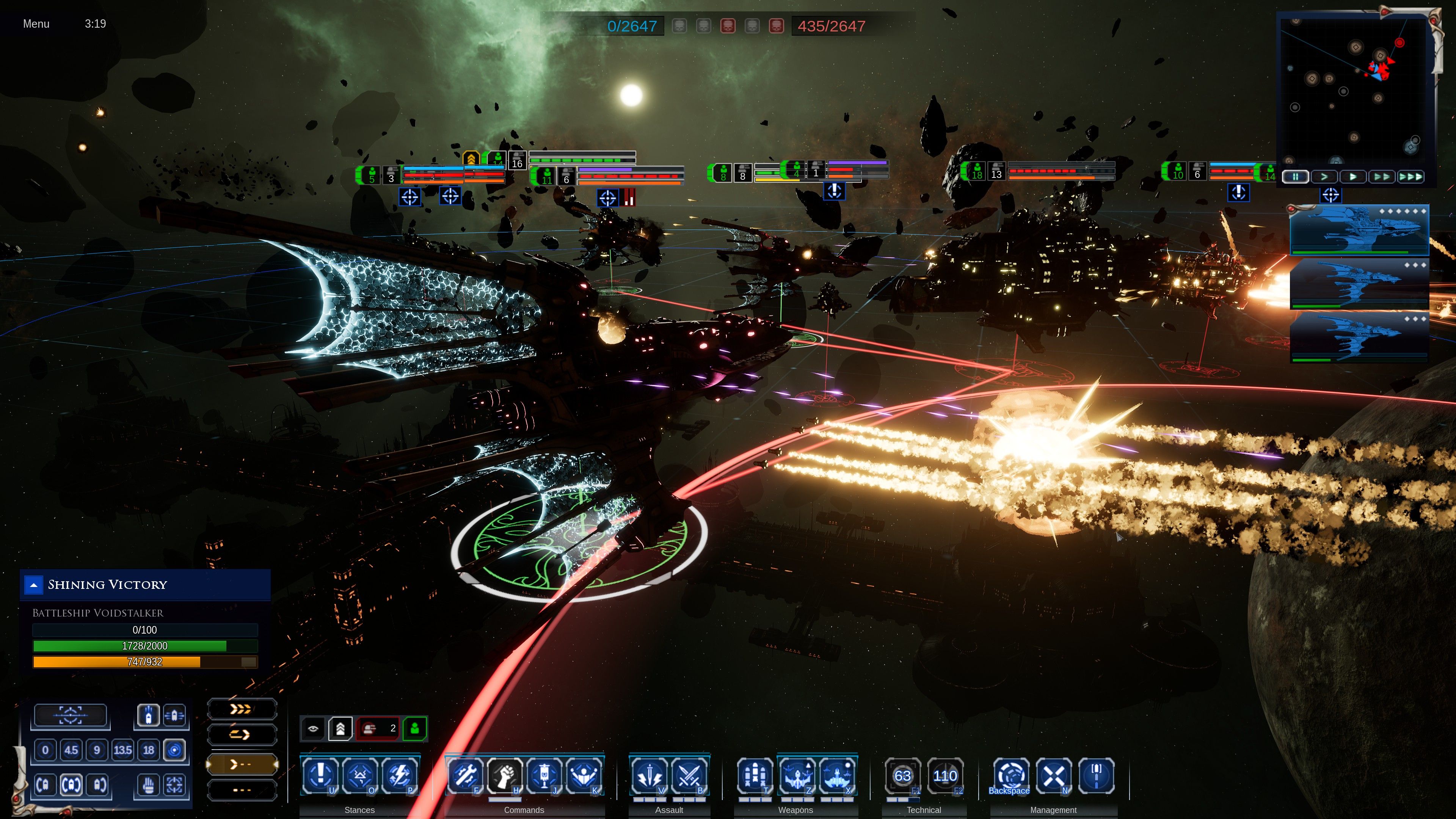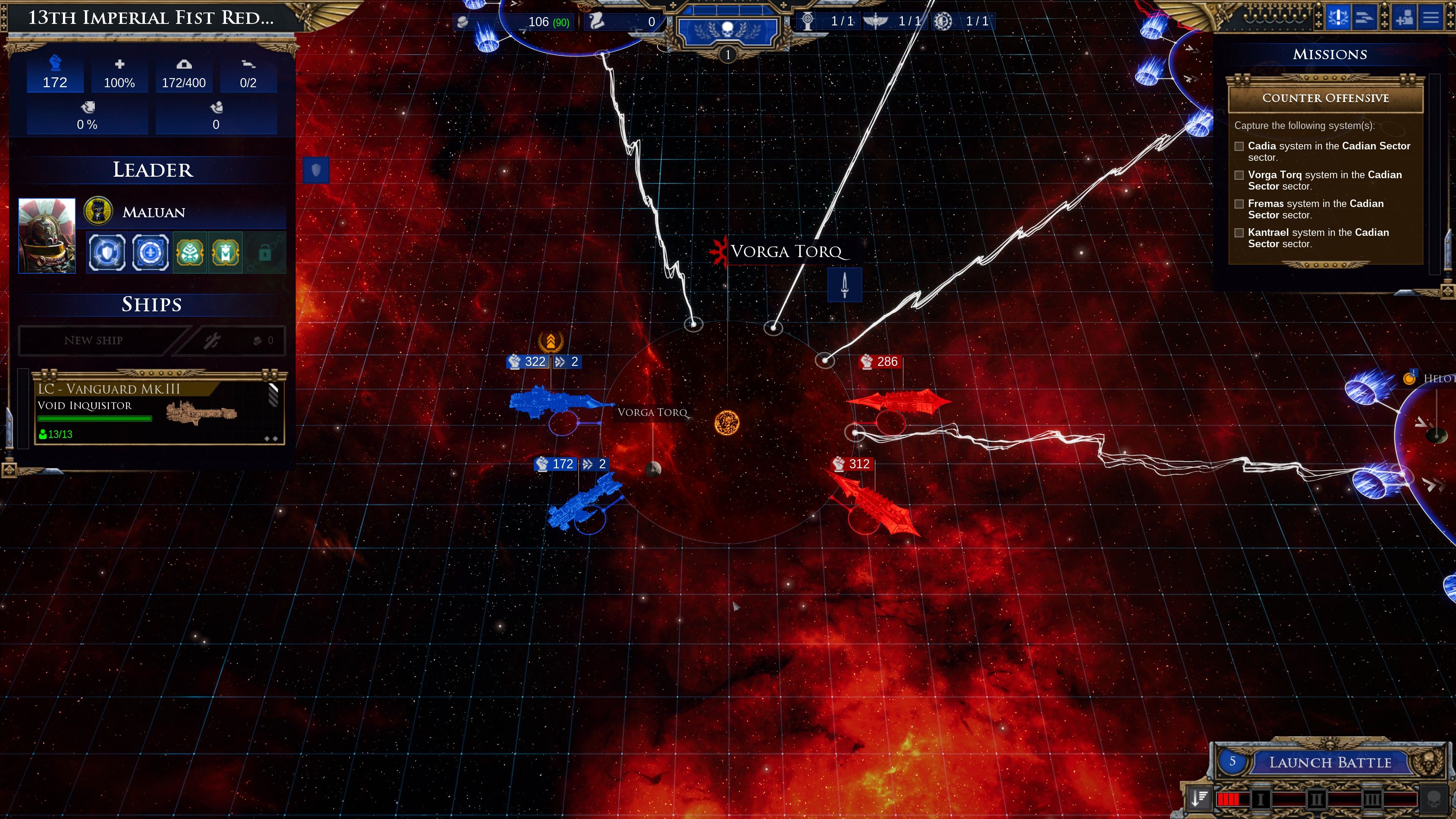Our Verdict
Involved, spectacular, space battles packaged into satisfying campaigns, and great fan service too.
PC Gamer's got your back
What is it? A real time tactics game set in space, in the Warhammer 40,000 universe.
Expect to pay $40/£35
Developer Tindalos Interactive
Publisher Focus Home Interactive
Reviewed on Intel Core i5-2500k, 16GB, Geforce GTX 970
Multiplayer? 1v1 or 2v2 ranked play
Link Official site
In a blazing purple storm of energy, my capital ship emerges from the alternative universe that vessels use for faster-than-light travel in Battlefleet Gothic. To get anywhere fast in the 41st millennium, spaceships have to go to space-hell and back, risking eternal damnation with every jump. To use a jump to hop halfway across a map and nuke an enemy ship point-blank is audacious, even foolish, but it captures everything that’s good about Battlefleet Gothic: Armada 2. It’s an indulgent strategy game wrapped in preposterous, exciting space nonsense.
Armada 2 is a real time tactics game about giant spaceships clashing in the Warhammer 40,000 universe. Battles take place on a 2D plane populated by capture points and asteroid fields. The ships handle like cruise liners, and each vessel has a whole dashboard of special abilities. Smaller escorts can scan the map and identify enemy vessels. Cruisers and larger battleships can unleash fighter and bomber squadrons, torpedo barrages, laser attacks, and boarding actions.
In order to complete my bold jump attack I need to pause the fight. Then, after enjoying the spectacle for a moment and taking the screenshot at the top of this review, I give my flagship vessel some commands. You can give ships special manoeuvre orders like ‘all ahead full’ to burst forward quickly, but for this attack
I need mobility. I select an order that essentially allows my city-sized capital ship to do a drifting turn. The Chaos ship fires boarding vessels directly into my flank as a last-ditch defensive measure, but it is certainly doomed.

As the Chaos ship powers away I order my capital ship to fire a brace of torpedoes right up its tailpipe. The Chaos ship’s hull bar melts away. A series of small messages announce fires on board. Then the crew on board mutiny. As the enemy sails towards a nearby asteroid field I’m left to imagine the crew tearing itself apart, moments before a final catastrophic explosion ends them.
Battles swing on these precise bursts of micromanagement, but Battlefleet Gothic 2 smartly blends directed automation and micromanagement to create a satisfying fleet commander simulator. An autopilot function orders ships to keep sensible range while firing. You can order enemy ships into a priority list that your fleet will strike ship-by-ship, and you can even target enemy subsystems to attack shields, crew, engines and weapons. That frees you up to manage special abilities and skillshot abilities like the plasma bomb, which procrastinates for ten seconds before erupting into a ball of deadly blue energy.
I almost don’t need the three included campaigns to get the most out of the game, but they provide a fun framework for skirmishes. As the Imperium, the immortal robot Necrons, or the monstrous Tyranids you conquer sectors of the galaxy by shuffling fleets around turn-based sector maps. When you move into a sector occupied by the enemy, you launch a real time battle to decide who claims it. There are light building systems that let you develop planets to generate resources and buy more ships, but it isn’t too detailed. If you’re after a serious 4X game, this isn’t it, but there’s enough structure there to give battles context and create consequences for losing.

There are some pretty good directed missions (and be sure not to miss out on the glorious spectacle of the prologue campaign), but you’re frequently playing set scenarios that are a bit of a let down. Capture points spread wide across a map can create scattered and messy battles. There are minor presentation issues too. The vivid backgrounds can make battlefields hard to read, and interface icons aren’t distinct enough to be quickly readable to me, even now I’ve learned what they all are.
In spite of the niggles, it’s an absorbing space strategy game, and we don’t get enough of them. The many featured factions are as varied and characterful as you would expect from the 40K universe. Tyranids infect enemy vessels with swarms of hungry monsters, and latch onto enemies with long space tentacles. The Eldar are fast and near-invisible at the start of a fight. The Orks, well, they crash into stuff. If you’re a fan of the universe there is even more to enjoy here. The voice acting sometimes goes full ham, but this is one of the most authentic attempts to capture the grandiosity of Warhammer 40,000. Emperor knows, many have tried.
Involved, spectacular, space battles packaged into satisfying campaigns, and great fan service too.
Part of the UK team, Tom was with PC Gamer at the very beginning of the website's launch—first as a news writer, and then as online editor until his departure in 2020. His specialties are strategy games, action RPGs, hack ‘n slash games, digital card games… basically anything that he can fit on a hard drive. His final boss form is Deckard Cain.



